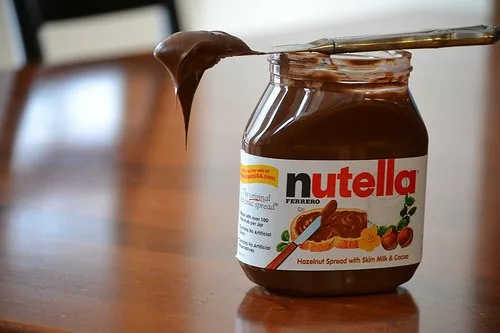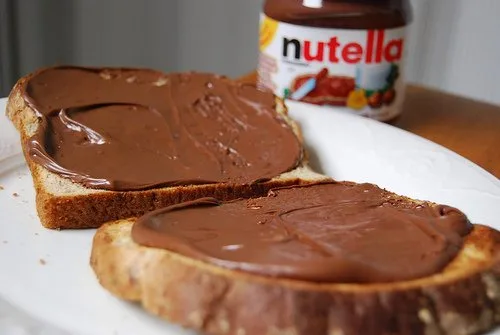Let’s talk about whether Nutella goes bad, how long it lasts, and whether you should ever put it in the fridge.
Say you found a half-open jar of Nutella that’s a couple of months beyond the printed date. Should you discard it? Does Nutella go bad?
Or maybe you just opened a fresh jar, and you’re wondering how long Nutella lasts or whether you should refrigerate it.
If either sounds familiar, you’re in the right place.
Read on.
All the info below stays true no matter if we’re talking about Nutella jars, single-serving portions, or those large Nutella tubs and piping bags.

Image used under Creative Commons from allison.hare
Table of Contents
- Does Nutella Go Bad?
- How to Tell if Nutella Is Bad?
- How Long Does Nutella Last?
- Does Nutella Need to Be Refrigerated?
- Nutella’s Shelf Life and Spoilage Summary
Does Nutella Go Bad?
Nutella doesn’t last forever, but it keeps quite some time, usually way beyond the printed date.
The popular spread is a mix that consists primarily of sugar and palm oil. That’s why it’s not nearly as prone to going rancid as peanut butter or almond butter are.
But that doesn’t mean Nutella retains quality indefinitely – somewhere along the line, it’ll either dry out and harden or start to separate oil. And if stored long enough, you’ll get to a point the quality of the spread isn’t nearly as good as it used to be. That’s when you toss it.
Of course, quality change isn’t the only way Nutella could go bad. Let’s talk about spoilage signs.
How to Tell if Nutella Is Bad?
Discard Nutella if:
- The texture has changed. The spread is no good if the once soft and creamy texture has become hard and dry (except if you placed it in the fridge, that’s reversible). Same if there’s a lot of separated oil on the surface (unlike peanut butter, where separation is expected). A bit of oil on top is okay; you can just stir it in.
- It smells rancid or harsh. If your Nutella smells weird, it’s probably rancid, as palm oil and hazelnuts can go rancid.
- There’s mold. Mold on Nutella is quite unlikely to happen, but if you ever notice any fuzzy action on the surface, it’s time to let it go.
- It’s stored for too long. If your Nutella is like six months beyond the best-by date, it’s probably best to toss it, no matter the quality.
- The taste is off. If you notice that the flavor has altered (say, the spread is bitter and harsh), it’s a good sign to get rid of it. It might be rancidity, might be something else, but it should end up in the bin anyway.
As always, if there’s anything else about your Nutella that you find concerning, trust your intuition and get rid of the spread. Better safe than sorry.
Next, let’s talk about how long Nutella stays good for.

Image used under Creative Commons from Janine
How Long Does Nutella Last?
Nutella comes with a 12-month shelf life and easily lasts for at least a few months beyond the printed date.
Once you open the jar, the storage time doesn’t change – Nutella retains quality for at least until its date, and more likely a couple of months past it.
That’s the gist of it.
Now, you might want to know what “a couple of months” past the date on the label exactly means. Let’s discuss that.
“Expiration” Date
The date printed on the Nutella jar isn’t an expiration date but a best-by date that informs you how long the product should retain its quality. And in the case of Nutella, it tends to stay okay quality-wise for months past that date.
In other words, it’s safe to eat Nutella that’s beyond the printed date, as long as it doesn’t show any signs of spoilage and doesn’t sit around for too long.
(Of course, the brand asks you to discard the spread if things ever get this far because they can’t guarantee quality.)
So, how long past the printed date is Nutella good for?
Unfortunately, there isn’t a precise answer I can give you. I suggest eating it within a couple of months beyond the printed date and tossing it if it’s more than half a year “expired.”
That said, yours might as well keep for much longer or start to degrade sooner, so it’s up to you to watch it closely and decide for yourself.
Finally, it also depends on what you’re comfortable with. If you’re not okay with eating Nutella that’s a couple of weeks “off,” there’s no point in forcing yourself. Tossing it is a better decision in this case.
Does Nutella Need to Be Refrigerated?
Nutella doesn’t need refrigeration after opening, and you shouldn’t store it in the fridge because it will harden and become difficult to spread. Instead, it’s best to keep the spread tightly sealed at room temperature between 64° and 72°F (18° and 22°C).
Besides cold temperatures, Nutella doesn’t particularly like excessive heat, which causes separation and flavor change. Because of that, it’s best to keep it in a kitchen or pantry cupboard and not on the countertop in direct sunlight.
Finally, always use clean spoons when scooping Nutella and never double-dip. Nutella doesn’t go bad easily, but that doesn’t mean you should help it spoil.
What Should You Do if You Accidentally Put Nutella in the Fridge?
If you refrigerated Nutella by accident and it’s hardened, return it to its usual storage spot at ambient temperature and give it about a day to soften back up. It should be nice and spreadable after those 24 hours, or less if the jar is half open.
What you shouldn’t do here is to try warming it up quickly using a microwave or a water bath. That’s a surefire way to shorten the spread’s shelf life and worsen the quality.
Nutella’s Shelf Life and Spoilage Summary
Thanks for reading this primer on Nutella. Here are the takeaways:
- Discard Nutella if its texture has changed (it’s dried up or separated noticeably), it smells off, or if the flavor has changed. And make sure you don’t have it around for more than a couple of months beyond the printed date.
- Nutella has a shelf life of 12 months and easily lasts for a couple of months beyond the printed date. Opening the jar doesn’t change much – the spread still keeps for months without noticeable changes in quality.
- Store Nutella in a cool and dark place, sealed well, but don’t refrigerate it as it will cause the spread to harden and become difficult to spread. A cupboard in the kitchen works great in most cases.